KILLER ROSES AND A HUNCHBACK HORROR
As disease follows famine, the 100 Years War succumbed to the War of the Roses. It makes sense that the titles of the two parts of Barbara Gaines’ massive compilation Tug of War are “Foreign Fire” and, now, “Civil Strife.” Whether a ground-grabbing feud between 15th-century England and France or an internecine fight for the crown between the Red Rose of York and the White Rose of Lancaster, it’s the same tug of war, waged over–as it dangles and swings high over the Courtyard stage of Chicago Shakespeare Theater–a golden tire or gilded inner tube. Anyway it’s the throne of England.
“Foreign Fire” compressed Edward III, Henry V and Henry VI, Part 1 into an action-packed, rock music-ridden pageant of hubris and chutzpah, mass homicide for temporary territory, alpha females, propaganda supremacy and body counts.
Here the extremes of human dysfunction are on dress parade’”and, of course, the reason is the author. Drawing on Holinshed’s chronicles and not immune to a politically-correct Tudor bias against the Plantagenets, Shakespeare remains unrivaled in his power to convey the price of predation, both for commoners, nobles, and their hapless or opportunistic women.
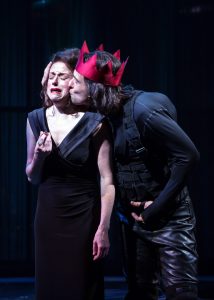 Over these six hours (with two intermissions and a dinner break), we get a crash course in the ravages endured by the homeland and the fratricidal cost as fathers kill sons and killers wed their victims. (The entire epic is curiously framed by the mutely running tale of a young soldier going off to war, losing his limbs, suffering from PTSD, abandoned by his not so faithful girl, and comforted by a band of brothers.)
Over these six hours (with two intermissions and a dinner break), we get a crash course in the ravages endured by the homeland and the fratricidal cost as fathers kill sons and killers wed their victims. (The entire epic is curiously framed by the mutely running tale of a young soldier going off to war, losing his limbs, suffering from PTSD, abandoned by his not so faithful girl, and comforted by a band of brothers.)
Distilling the lethal essence of the second two parts of Henry VI and all of Richard III, “Civil Strife” feels even more contemptibly contemporary than its spring predecessor. It amounts to a kind of vicious demonization of an American presidential campaign: Indeed, as the know-nothing, populist firebrand Jack Cade, Keven Gudahl delivers an exact impersonation of moronic Donald Trump, complete with flaming orange wig and hideous mouth-mockery of the disabled. But Tug is also deliberately deflated: In domestic contrast, we glimpse a very and un-Shakespearean scene–of fearsome warriors taking a break to fish in some doubtless bloody creek.
The carnage beings with the feudal forces of England choosing their rose’”red or white’”in a dynastic duel to the death. In the first half a religious, weak-willed and cerebral Henry VI (Steven Sutcliffe), who should have been a monk, not a monarch, engages in full-out battle with the soon-to-triumph House of York, embodied by Larry Yando’s howlingly ambitious Duke. Encouraged by his bloodthirsty consort Margaret (a toxic Karen Aldridge) and opposed by carnivorous lords who despise the vacuum that Henry VI represents and creates, the king’s fortunes wax and wane, as does the propulsive score by Pink.
The second half is even more technologically anachronistic, with a media-savvy press conference and a huge video collage of victims cursing a serial-killing king (“Despair and die!”). It belongs, of course, to Shakespeare’s vilest historical villain. Following the convenient disposition of Henry VI, then his clueless brother Edward IV (Michael Aaron Linder), Timothy Edward Kane, a force field on any stage, plays the last of the Plantagenets.
Richard III is a histrionic, “bunch-backed” monster of contagious venom and literally crippled corruption. The disabled devil seduces Lady Ann (anguished Elizabeth Ledo), a widow and orphan that he created, puts to death the teenage princes in the Tower (Ledo and Kyri), betrays his sordid ally Buckingham (James Newcomb), and casually offs his venal brother Clarence (John Tufts) in an unseen butt of Malmsey. He also dispatches assorted clumsily plotting gentry (Daniel Kyri, Michael Milligan and Sutcliffe). He is the winter of his discontent.
Happily, the fiend receives an infamous horseless reckoning in 1485. A true turning point, the Battle of Bosworth Field ushers in heroic Henry Richmond (Kryi), the future Henry VII, first of Shakespeare’s equally flawed Tudors. (Hundreds of years later, the deformed bones of Richard III are finally discovered’”in a Leicester parking lot.)
Rampaging beneath giant scaffolding, the combatants, dressed in Kevlar vests and wielding state-of-the-art weaponry, rush up and down the aisles, their sanguinary harvests measured by huge spills of blood across a white backdrop that turns dark red by saga’s end. (Scott Davis’ scenery should take its own bow, as well as Susan E. Mickey’s modern wardrobe.)
As she unleashes the dogs of war (18 of Chicago’s terrific thespians), Barbara Gaines rightfully and purposefully condenses six of the Bard’s history plays into an action lesson in self-defeating slaughter. The result is a 12-hour carnival of cruelty, a tale of sound and fury signifying something’”a throne so soaked in blood the wood should rot to the core. Perhaps not for all seasons or sensibilities, Tug of War is a ferocious feat. Now on Navy Pier, the past returns, helpless to prevent our future.
photos by Liz Lauren
Tug of War: Civil Strife
Chicago Shakespeare Theater
Courtyard Theater on Navy Pier
ends on October 9, 2016
for tickets, call 312.595.5600 or visit Chicago Shakes
for more shows, visit Theatre in Chicago
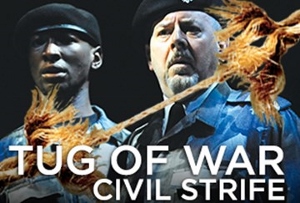
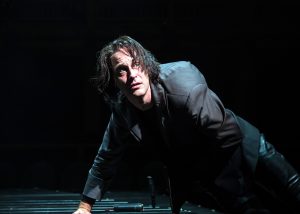
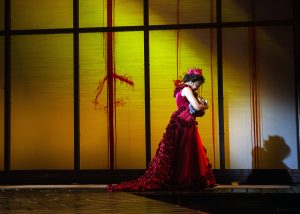
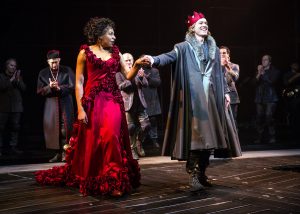
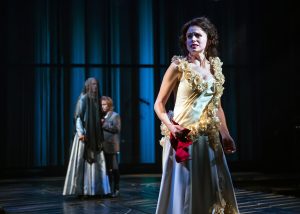
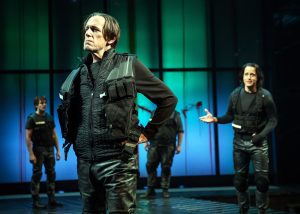

{ 2 comments… read them below or add one }
You’ve got the roses reversed in your opening. York is white.
The score is NOT by Pink. It features two songs by her. Goodness gracious.